장비 유지 보수 및 수리








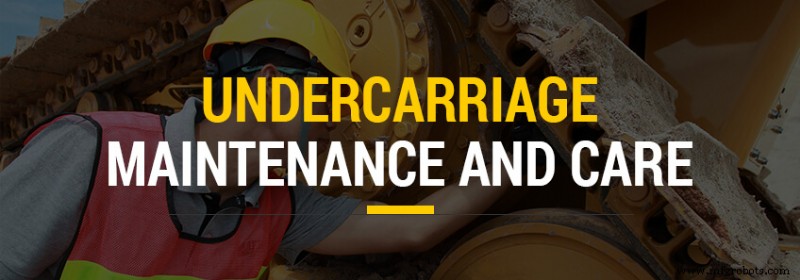
선로에 의존하는 중장비를 소유하거나 운영하는 경우 차대가 장비의 중요한 부분입니다. 크롤링 장비는 복잡하며 가혹하고 가혹한 조건을 견딜 수 있도록 제작되었습니다. 하지만 영구적인 장비는 없습니다. 차대 유지 관리 및 관리에 들인 노력은 구성 요소 수명 연장과 지속적인 작업 시간에 막대한 영향을 미칩니다.
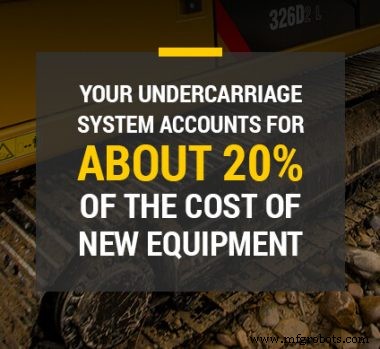 궤도를 기어다니는 중장비는 크고 중요한 투자입니다. 차대 시스템은 새 장비 비용의 약 20%를 차지합니다. 대조적으로, 차대는 유지 관리 예산의 약 50%를 차지합니다. 장비 투자를 최대한 활용하려면 적절한 차대 예방 유지보수가 필수적입니다.
궤도를 기어다니는 중장비는 크고 중요한 투자입니다. 차대 시스템은 새 장비 비용의 약 20%를 차지합니다. 대조적으로, 차대는 유지 관리 예산의 약 50%를 차지합니다. 장비 투자를 최대한 활용하려면 적절한 차대 예방 유지보수가 필수적입니다.
차대 유지 관리에는 일상적인 차대 검사를 수행하는 것보다 더 많은 것이 있습니다. 두 가지 기본 차대 관리 원칙은 청결을 유지하고 적절한 장력을 유지합니다. 이러한 핵심 사항 외에도 애플리케이션, 지형, 작업자 기술 및 작업에 적합한 트랙 사용을 포함하여 시간이 지남에 따라 장비 마모에 영향을 줄 수 있는 여러 요소가 있습니다.
토공 장비 기술은 계속 발전하고 진화합니다. 오늘날의 장비는 과거의 굴삭기, 도저 및 소형 트랙 로더보다 훨씬 더 신뢰할 수 있고 내구성이 있습니다. 이제 트랙 옵션을 훌륭하게 선택할 수 있으며 성공적인 작업의 핵심은 고유한 요구 사항에 적합한 옵션을 선택하는 것입니다.
장비를 작동하는 조건은 다양할 수 있기 때문에 보편적인 트랙은 없습니다. 부드러운 모래나 진흙에서부터 씹는 암석과 철거 잔해에 이르기까지 모든 것을 경험할 수 있습니다.
엔지니어는 중량을 효과적으로 이동시키기 위해 장비 트랙을 설계합니다. 트랙이 장착된 장비는 바퀴가 달린 장비보다 설치 공간이 훨씬 작거나 지면 압력이 낮고 견인력도 더 높습니다. 그러나 트랙은 일부 표면에서 단단할 수 있으므로 Caterpillar와 같은 주요 장비 제조업체에서 다음 두 가지 트랙 재료 옵션 중에서 선택할 수 있습니다.
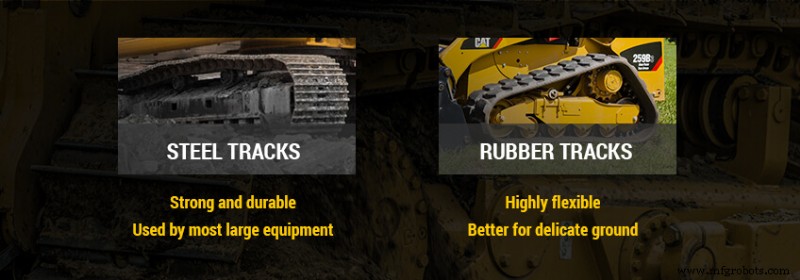
고무 또는 강철로 달리더라도 여전히 중요한 필요한 차대 지원. 차대 구성 요소를 사용하면 기어가고, 회전하고, 똑바로 서 있을 수 있습니다. 또한 트랙 정렬과 적절한 장력 균형을 제공하여 장비가 오류 없이 작동할 수 있도록 합니다.
강철 또는 고무 트랙은 설계된 수명 내에서 신뢰할 수 있지만 차대는 항상 취약합니다. 차대는 움직이는 부품의 복잡한 시스템이며 고장을 방지하기 위해 특별한 주의가 필요합니다. 차대 고장은 치명적일 수 있으며 수리 비용이 매우 많이 듭니다.
고장 예방은 차대 유지 관리 프로그램의 핵심입니다. 차대 부품과 트랙이 알려주는 내용에 세심한 주의를 기울여야 합니다. 프로그램의 중요한 부분은 차대 마모에 영향을 미치는 요인과 조기 마모를 방지하기 위해 할 수 있는 일을 이해하는 것입니다.
모든 차대 구성 요소는 시간이 지남에 따라 자연스럽게 마모되며 서비스 기대치가 제한됩니다.
차대 마모에는 특정 시간 제한이 없습니다. 작동 시간으로 서비스 수명을 측정하지만 장비의 차대가 얼마나 오래 지속되는지에 대한 정해진 비율은 없습니다. 부품 수명은 작업 현장에서 경험하게 될 다양한 요인에 따라 크게 달라집니다. 차대 마모에 영향을 미치는 주요 요인은 다음과 같습니다.
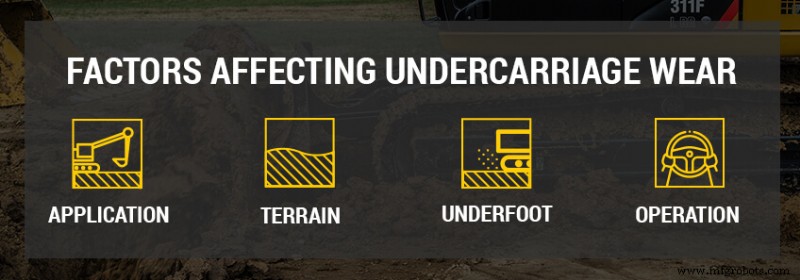
운전자가 장비를 책임감 있게 작동하도록 교육하면 불필요한 차대 마모를 쉽게 방지할 수 있습니다. 모니터링하여 작업자 마모를 최소화할 수도 있습니다. 이러한 개입만으로도 차대 유지 및 수리 비용을 많이 절약할 수 있습니다.
대부분의 장비 운영자는 해를 입히려는 의도가 없습니다. 작업자의 피해는 경험 부족이나 적절한 교육 부족으로 인해 발생하는 경우가 많습니다. 장비 차대를 마모시키는 작업자가 발견할 수 있는 주요 실수는 다음과 같습니다.
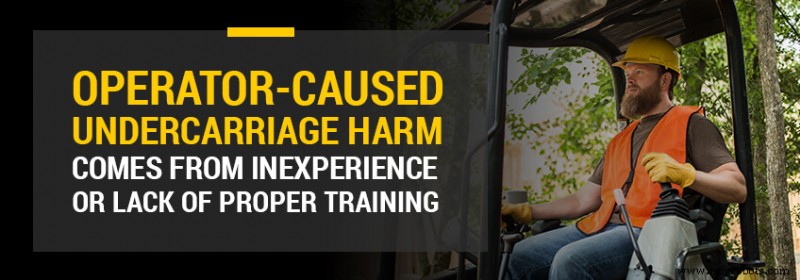
하체가 움직일 때마다 부품이 마모됩니다. 그러나 부품이 마모되고 교체될 것으로 예상되더라도 수명을 연장하기 위한 조치를 취할 수 없다는 의미는 아닙니다. 운전자를 교육하고 차대 유지 관리 프로그램의 일부가 되도록 하는 노력은 보상을 받을 것입니다. 직원이 취할 수 있는 주요 단계 중 하나는 매일 차대 검사를 수행하는 것입니다.
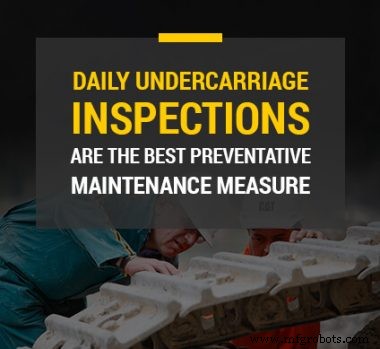 일일 차대 검사
일일 차대 검사장비 운영자가 차량에 개인적인 이해 관계가 있는 경우 올바르게 취급할 가능성이 훨씬 높습니다. 그들은 차대에 가해지는 측면 스트레스를 피하고 후방 드라이브에 굴착력을 가하지 않는 것과 같은 적절한 작동 절차에 주의를 기울일 것입니다. 그들은 생산적으로 작업하기에 충분한 속도로 이동하지만 구성 요소의 마모를 줄이기에는 충분히 느립니다.
교환원은 장비에 가장 가깝고 문제가 발생하기 시작할 때 조기 경보를 받을 수 있는 훌륭한 출처입니다. 운영자가 잠재적인 문제를 즉시 보고하도록 권장하십시오. 일반적으로 일일 차대 검사를 통해 문제를 발견했을 가능성이 있습니다.
매일 차대 검사를 수행하는 것은 팀이 취할 수 있는 최상의 예방 유지보수 조치 중 하나입니다. 검사에는 많은 시간이 걸리지 않지만 장기적으로 성과가 있습니다. 다음은 일일 차대 검사를 수행할 때 확인해야 할 주요 사항입니다.
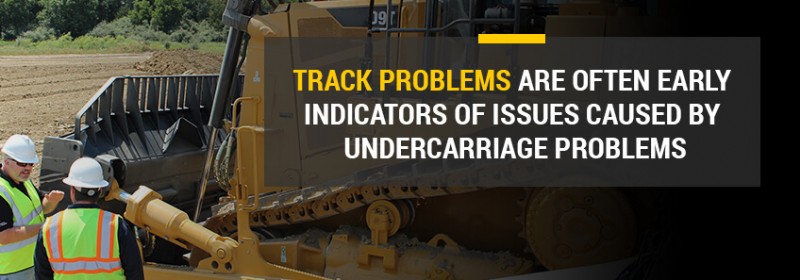
차대는 일일 검사를 확인하는 장비의 유일한 부분이 아닙니다. 당신의 흔적도 주시하는 것이 중요합니다. 궤도 문제는 차대 문제로 인해 발생하는 문제의 초기 지표인 경우가 많습니다. 트랙에서 매일 점검해야 할 사항은 다음과 같습니다.
트랙은 전반적인 차대 성능에 막대한 영향을 미칩니다. 대부분의 장비 제조업체와 운영자는 트랙을 스프로킷, 드라이브, 링크, 롤러 및 아이들러와 같은 실제 차대 구성요소와 약간 별개의 개체로 간주합니다. 트랙과 차대 어셈블리는 모두 기술적으로 별도의 시스템이지만 각각이 서로를 지원합니다.
고무 트랙이든 강철 트랙이든 매일 검사하고 적절한 유지 관리가 필요합니다. 차대가 제대로 작동하려면 마모가 적고 자유롭게 움직이는 부품이 필요하며, 이를 위해서는 먼저 트랙 장력을 조정해야 합니다.
올바른 트랙 장력을 유지하는 것은 차대 시스템의 수명을 연장하는 데 매우 중요합니다. 트랙 장력은 너무 조이지 않고 너무 느슨하지 않은 균형이 완벽해야 합니다. 이것은 달성하기 까다로울 수 있으며 적절한 트랙 장력은 특정 요인에 따라 다릅니다.
트랙이 빡빡하면 모든 차대 구성 요소에 불필요한 저항이 생깁니다. 차대의 모든 움직이는 부분과 고정된 부분이 스트레스를 받습니다. 이는 조기 마모와 값비싼 수리로 이어집니다.
트랙이 너무 느슨하면 차대에도 스트레스가 가해집니다. 느슨한 트랙은 방황하고 정렬에서 벗어나 시스템에 측면 응력을 가합니다. 너무 조이는 것과 마찬가지로 느슨한 트랙은 차대를 마모시키고 비용을 초래할 수 있습니다.
올바른 트랙 장력을 설정하는 것은 다양한 요인에 따라 다릅니다. 트랙 장력은 특정 장비 설계, 개별 트랙 유형 및 실제 작업 조건의 문제입니다. These are the main factors concerning track tension:
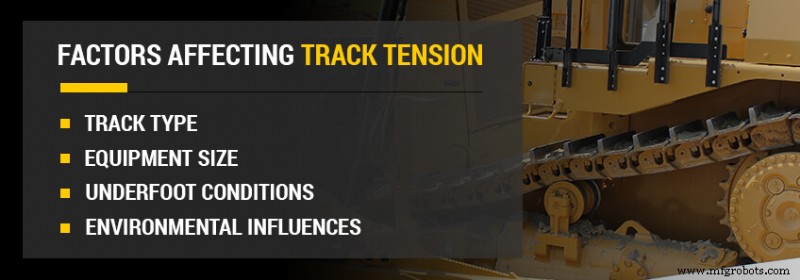
Setting your track tension to get the best performance from your undercarriage can be an art of its own. Track tension is equipment-specific but it has an important influence on your undercarriage wear. The best step you can take is referring to your original equipment manufacturer’s manual like those that come with your Cat
®
equipment.
You’ll likely come across the word “sag” when you’re investigating how to set your track tension. Sag is the dip or drop you’ll see in your track at the upper plane where it’s not affected by ground compression. Your manufacturer will have a sag guide table that gives ideal tolerances for track tension.
You’ll find a lot of variance in track tension tolerances. Big excavators with standard sprocket designs and large steel tracks have different sag rates than rubber-equipped compact track loaders with elevated sprocket designs. When in doubt about track tensions, always contact your equipment dealer for professional advice.
Professional advice from a reputable dealer will save you a lot of headaches when it comes to undercarriage issues. They know the tension tolerances needed for top performance and will always advise you of the most important rule in undercarriage maintenance — keep it clean.
Cleaning your undercarriage is the simplest and safest way to make your undercarriage last as long as possible. Your undercarriage is a complex system of moving parts that can break down when it gets too dirty. Regular cleaning is undercarriage management 101.
It might take a lot of effort to clean your undercarriage components properly, but it’s worth your time. What cleaning is necessary depends on what application you’ve put your tracked equipment through, what terrain you’ve operated it in and what underfoot conditions you’ve moved your tracks through. What’s deposited into your undercarriage assembly is a by-product of work. It’s also a mess that has to come out.
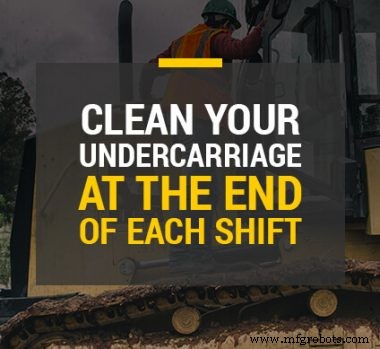 Cleaning your undercarriage is an ongoing event. It’s best to get it done and over with right at the end of each shift. It’s not wise to let a dirty undercarriage sit overnight. In warm weather, gunk can dry and harden. In cold times, it’ll freeze and bind. Either way, it’s going to be a lot harder to clean your undercarriage later than sooner.
Cleaning your undercarriage is an ongoing event. It’s best to get it done and over with right at the end of each shift. It’s not wise to let a dirty undercarriage sit overnight. In warm weather, gunk can dry and harden. In cold times, it’ll freeze and bind. Either way, it’s going to be a lot harder to clean your undercarriage later than sooner.
Dirty undercarriages lead to a number of problems over time. Built-up debris will jam your moving parts and can cause components to snap under protest. Grit also leads to abrasion and premature wear. You’ll also have lower fuel efficiency where there is resistance from clogged tracks and stuck undercarriage parts. Here are some undercarriage cleaning tips to help your preventative maintenance program:
Whatever undercarriage cleaning method you try, make sure you stick with it regularly. Clean undercarriages are long-living assemblies, and they’ll save you a lot of time and money. Cleaning is extremely important for your overall undercarriage preventive maintenance plan.
It’s always important to bring up track and shoe size when talking about undercarriage maintenance. Having the proper track width and shoe size for your task has a big effect on performance. If your track and shoe combination is oversized, the unnecessary weight and bulk will wear your undercarriage components. If your track and shoe assembly is too small, your flotation rate will suffer, and so will your undercarriage.
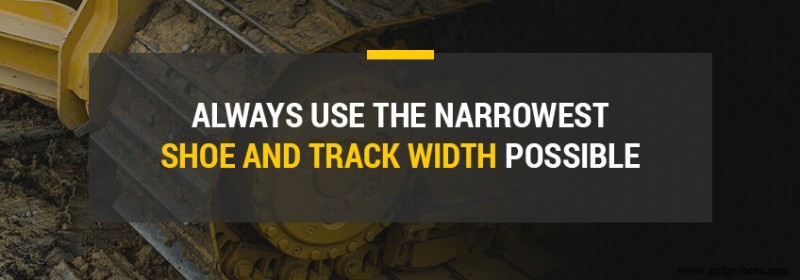
The rule to follow is always to use the narrowest shoe and track width possible. You still want adequate flotation for your terrain and underfoot conditions, but you don’t want to exceed the optimum rate. An oversized track and shoe assembly can cause these undercarriage issues:
Using proper-sized tracks and shoes is an important measure in the fight to keep your undercarriage alive as long as you can. So is keeping your undercarriage clean and always having the proper track tension adjusted for your application. Preventive maintenance is essential for several reasons.
There are many steps in the undercarriage maintenance process that are essential for ensuring our equipment is at peak performance. Cleaning your undercarriage regularly and adjusting your track tension certainly vital. Lubricating moving parts and replacing components when it’s time are very important as well. Daily inspections also compete for top prevention priority.
Failing to maintain your equipment’s undercarriage is a guarantee to have your equipment fail early. Unfortunately, undercarriages are wear items on all equipment like dozers, excavators and track loaders. But they don’t have to wear out and fail any sooner than necessary.
Undercarriage failure costs are expensive. In addition to repair bills, equipment failures due to poor undercarriage maintenance cost you in job site downtime. They can also cost you in business reputation.
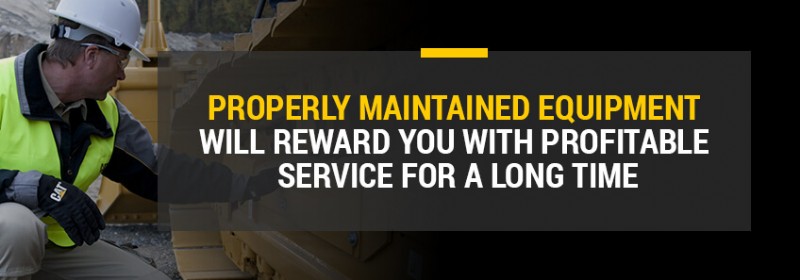
Your reputation, site time and bottom line don’t have to cost you due to undercarriage failure. If you properly maintain your tracked equipment, it will reward you with profitable service for a long time. Consider also partnering with an equipment dealer who knows the value you’ll get with an undercarriage preventive maintenance program.
Hey, I’m Dave with today’s Quick Tip and I’m here to help you make the most of your investment.
Make inspecting your undercarriage a part of your daily routine.
Look for cracks and damage to the tracks.
Remove excess amounts of dirt and large debris from your undercarriage.
Concrete, rocks and even hardened mud or dirt can increase the fraction your track experiences which will cause wear and may even cause the track to fall off.
Manually extract large items and the occasional power washing will help keep your undercarriage in good shape.
You should also look for loose hardware and oil leaks.
Know the grease points on your specific model.
It is important to grease them daily to lubricate the bushings on your undercarriage frames.
Proper greasing also helps push dirt out.
Tracks should not be too loose or too tight.
Refer to your operation and maintenance manual on the proper tension test procedures for your machine’s specific undercarriage.
Different styles of undercarriage have different tensioning procedures.
The proper track tension will extend the life of your undercarriage.
So remember, for healthy machine undercarriages apply these three simple rules:keep it clean, keep it greased, and keep it tensioned.
Consult your operation and maintenance manuals for more information.
That’s been today’s Quick Tip. Thanks for watching.
At MacAllister Machinery, we know how valuable your tracked equipment is. We realize undercarriage maintenance and servicing account for a large chunk of your overall maintenance budget. We want to help you spread your business costs over a long time, and we know that proper undercarriage attention is vital to you.
If your run tracks in Indiana or Michigan’s lower peninsula, partner with MacAllister Machinery for long-term undercarriage management and care. We have the undercarriage service you need to keep your Cat tracks turning and making you a high return on your investment.
Contact MacAllister Machinery today for your undercarriage management solutions. Call us at (317) 545-2151 or contact us online.
장비 유지 보수 및 수리
금속 절단기는 성능과 효율성을 보장하고 수명을 연장하는 데 핵심적인 관리와 유지보수가 필요합니다. 기계의 구성 요소가 무엇이든 정기 점검 및 유지 관리의 본질은 아무리 강조해도 지나치지 않습니다. 스핀들과 같은 고정밀 금속 절단 기계 부품을 부적절하게 취급하면 파손 지점에 도달할 수 있습니다. 적절한 관리와 유지보수는 최적의 운영 성능과 서비스 수명을 보장합니다. 금속 절단기는 주요 투자이므로 사용 설명서에 있는 특정 유지 관리 지침 및 지침을 참조하십시오. 장비 제조업체는 오랜 경험을 통해 장비 요구 사항을 알고 고객을 위한
일반적으로 유지 보수는 자산 장애가 발생한 경우와 계획된 유지 보수의 두 가지 요소를 기반으로 수행됩니다. 두 경우 모두 자산 상태가 양호하거나 너무 늦을 때 자산 유지 관리가 수행됩니다. 여기에서 상태 기반 모니터링 유지 관리가 작동합니다. 이 유지 관리는 사전 예방적이며 필요할 때 자산에 유지 관리가 제공됩니다. 이를 위해 자산을 정기적으로 검사하고 IoT와 같은 여러 자산 추적 기술을 사용합니다. 실시간 정보 제공에 도움이 되며 관리자는 자산을 최대한 활용할 수 있습니다. 이 블로그에서는 상태 기반 모니터링 유지 관리에 대한